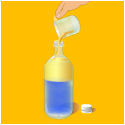




Experiment Category:
Objective:
What You Need:
- Clear plastic container with tight cap
- Water
- Food Coloring
- Mineral oil
To Do and Observe:
1. Fill the plastic container half full of water.
2. Add blue or green food coloring until the water gets dark.
3. Add mineral oil until the container overflows just a little.
4. Put the cap on tightly.
5. Now turn the container on its side, rock it gently, and watch the waves. Continue rocking the container – do the patterns change? Can you make the waves “collide?” What happens?
What's Going On:
When the bottle is at rest you can see that the oil sits on top of the water, you may have observed the same phenomenon in a salad dressing bottle. This happens because oil is less dense than water. Density is the mass per unit volume of a material. That means that the number of oil molecules in any given volume is fewer than that of water in the same volume. As the bottle is rocked, we are able to observe the wave patterns. If you rock the bottle with varying force you can create different patterns and you can also notice the interaction between the waves. As the waves meet they can cancel each other out or make bigger waves. We can also see how waves interact in large bodies of water, such as an ocean or lake.
Parent/Teacher Tips:
NOTE: Instead of mineral oil, you can try regular cooking oil, baby oil, or olive oil. They will all do the same thing.
For Older Children
Older children can observe, describe and sketch the waves using scientific terminology (wavelength, amplitude, interference, frequency. They can experiment with lots of different types of liquids to see if they all allow you to see the waves as they are formed and move around in the bottle. You might begin by asking children to describe the oil and hypothesize as to what they think makes the oil remain separate from the water. Children can experiment with liquid density by combining other liquids, such as syrup, paste or mouthwash, with water and/or oil.
